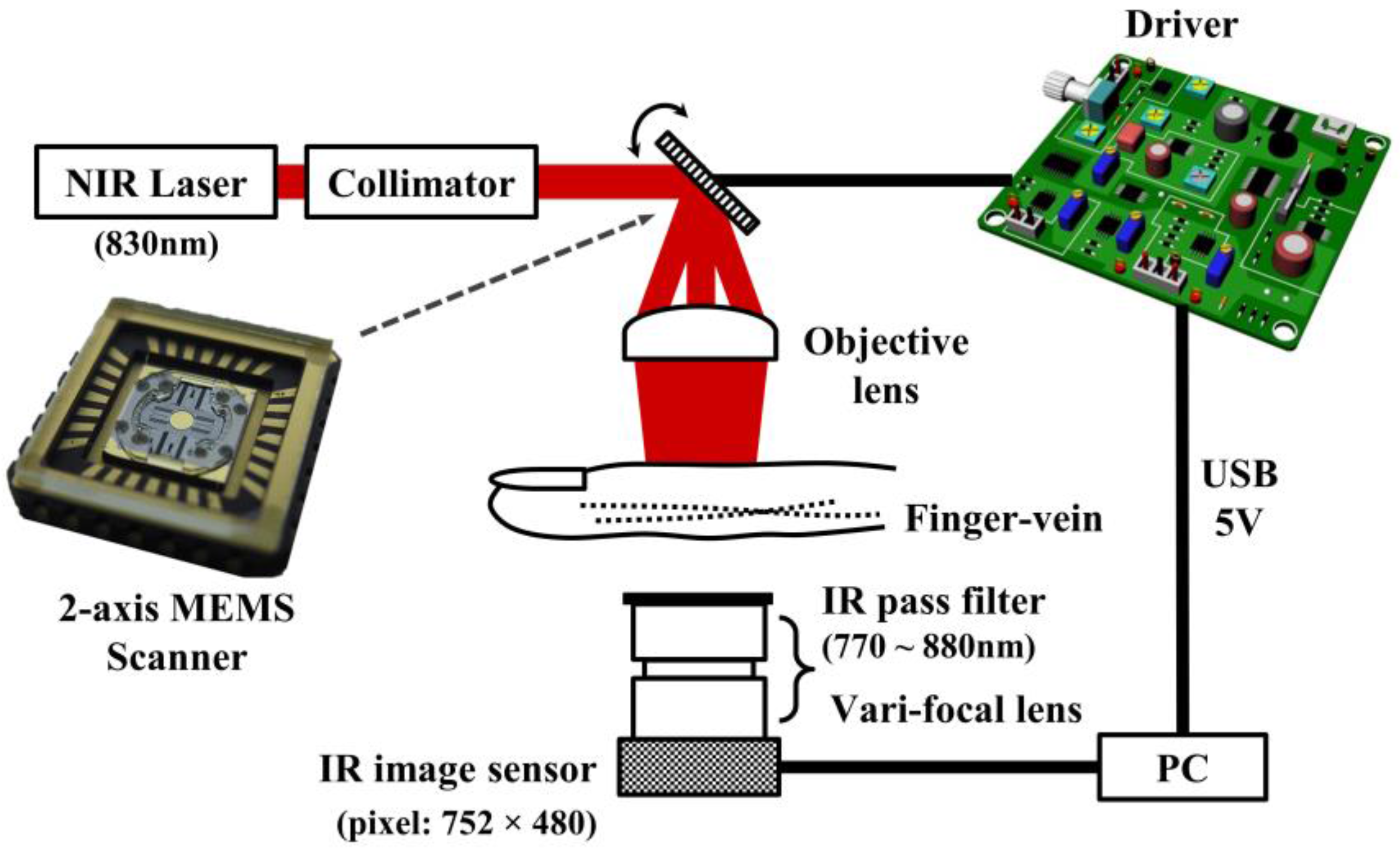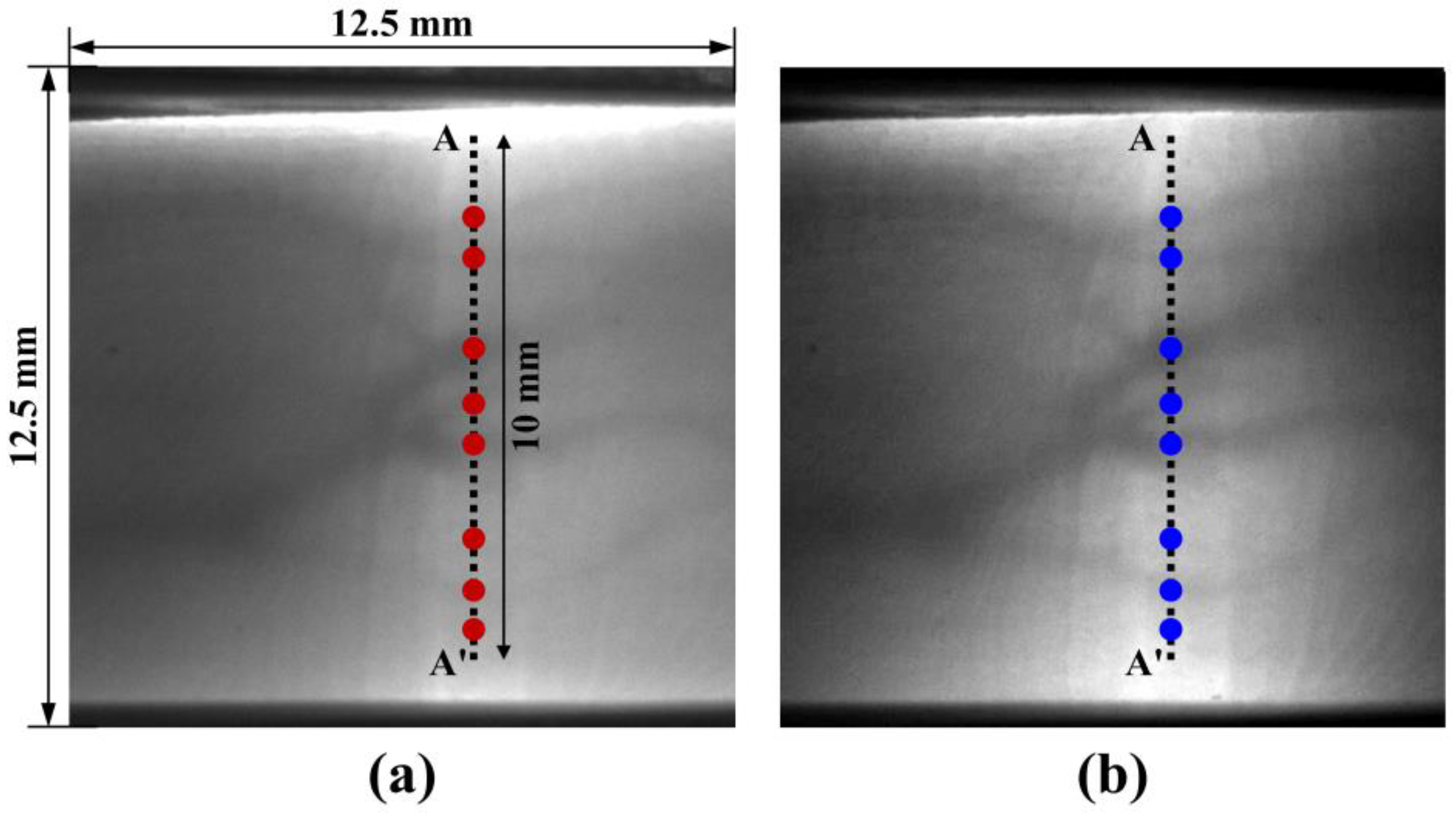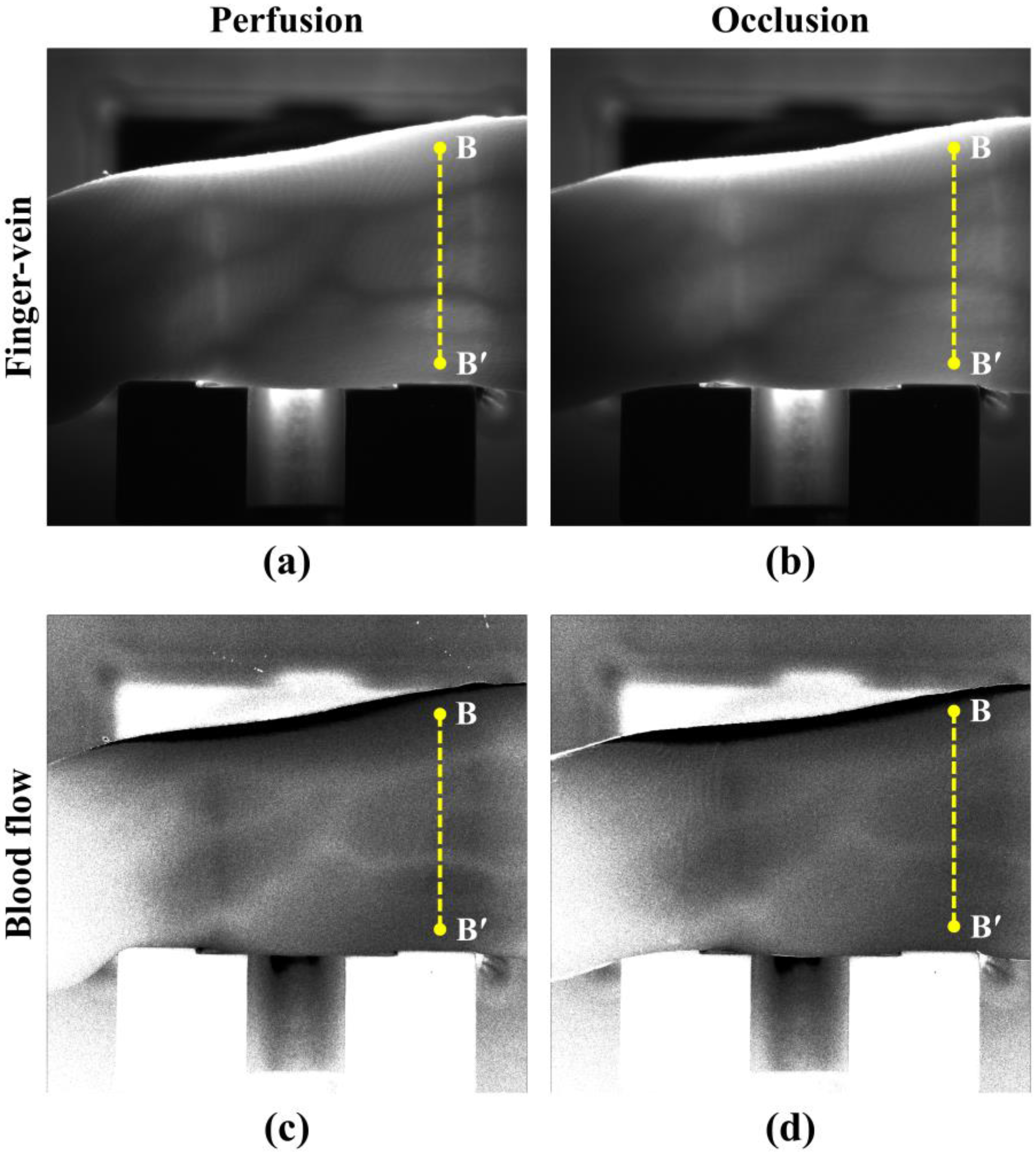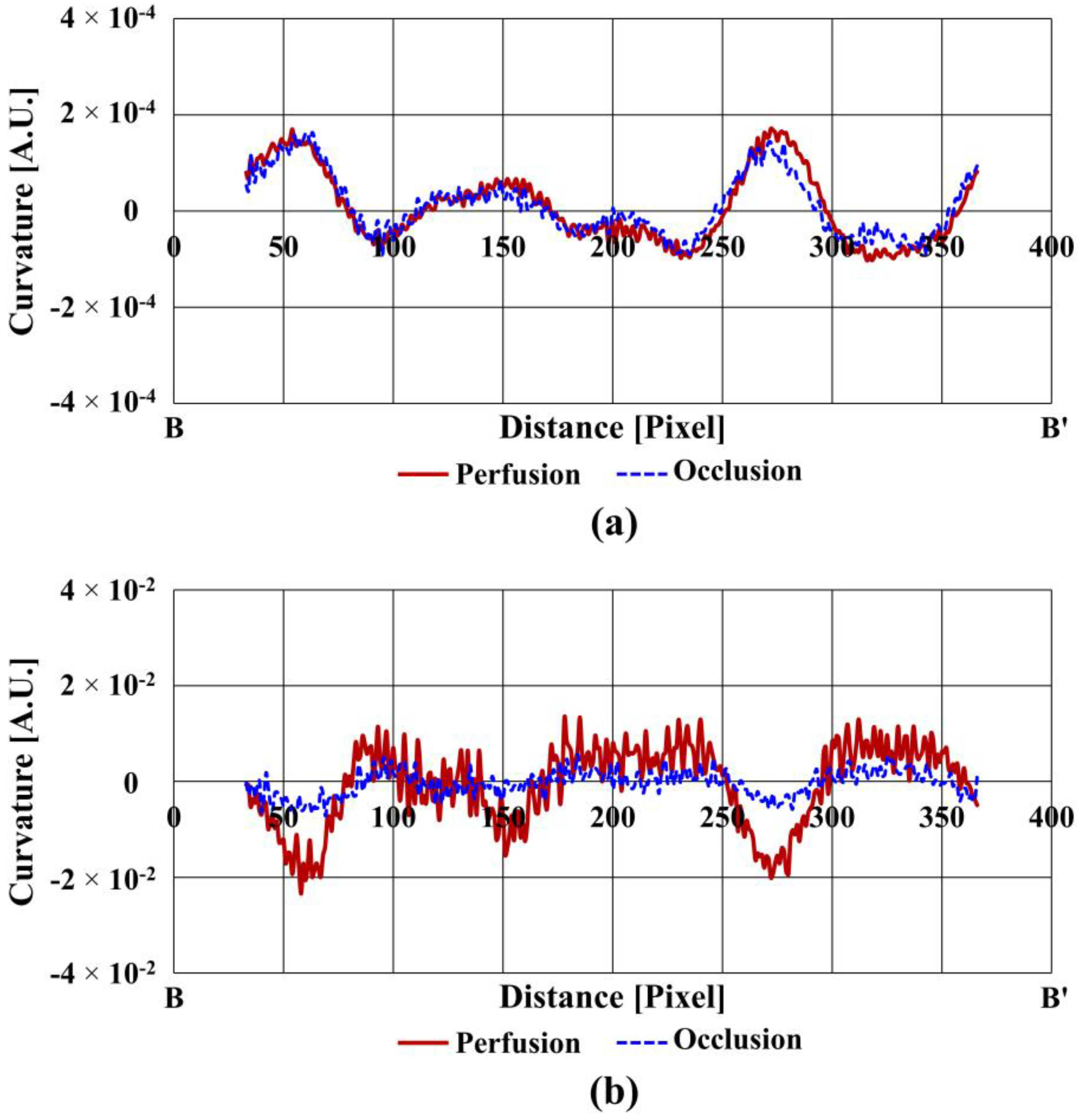Imaging of the Finger Vein and Blood Flow for Anti-Spoofing Authentication Using a Laser and a MEMS Scanner
Abstract
:1. Introduction
2. Finger Vein Imaging
2.1. Operation Principle
2.2. Quantification and Results
3. Blood Flow Detection
3.1. Operation Principle
3.2. Blood Flow Image Extraction
3.3. Quantification and Results
4. Conclusions
Acknowledgments
Author Contributions
Conflicts of Interest
References
- Xiao, Q. Biometrics-technology, application, challenge, and computational intelligence solutions. IEEE Comput. Intell. Mag. 2007, 2, 5–10. [Google Scholar] [CrossRef]
- Jain, A.K.; Ross, A.; Prabhakar, S. An introduction to biometric recognition. IEEE Trans. Circuits Syst. Video Technol. 2004, 14, 4–20. [Google Scholar] [CrossRef]
- Ruud, M.; Jain, A. Biometrics: The future of identification. Computer 2000, 33, 46–49. [Google Scholar]
- Yager, N.; Amin, A. Fingerprint classification: A review. Pattern Anal. Appl. 2004, 7, 77–93. [Google Scholar] [CrossRef]
- Aum, J.; Kim, J.; Jeong, J. Live acquisition of internal fingerprint with automated detection of subsurface layers using OCT. IEEE Photonics Technol. Lett. 2016, 28, 163–166. [Google Scholar] [CrossRef]
- Kono, M.; Ueki, H.; Umemura, S. Near-infrared finger vein patterns for personal identification. Appl. Opt. 2002, 41, 7429–7436. [Google Scholar] [CrossRef] [PubMed]
- Miura, N.; Nagasaka, A.; Miyatake, T. Extraction of finger vein patterns using maximum curvature points in image profiles. IEICE Trans. Inf. Syst. 2007, E90–D, 1185–1194. [Google Scholar] [CrossRef]
- Lee, E.C.; Jung, H.; Kim, D. New finger biometric method using near infrared imaging. Sensors 2011, 11, 2319–2333. [Google Scholar] [CrossRef] [PubMed]
- Pham, T.D.; Park, Y.H.; Nguyen, D.T.; Kwon, S.Y.; Park, K.R. Nonintrusive finger vein recognition system using nir image sensor and accuracy analyses according to various factors. Sensors 2015, 15, 16866–16894. [Google Scholar] [CrossRef] [PubMed]
- Kim, J.; Kong, H.-J.; Park, S.; Noh, S.; Lee, S.-R.; Kim, T.; Kim, H.C. Non-contact finger vein acquisition system using NIR laser. Proc. SPIE 2009, 7249, 72490Y. [Google Scholar]
- Lee, J.; Moon, S.; Lim, J.; Kim, K.; Lee, J.-H.; Gwak, M.-J.; Kim, K.S. A Finger vein imaging and liveness detection for identity authentication using 2-axis MEMS scanner. In Proceedings of the IEEE International Conference on Optical MEMS and Nanophotonics, Singapore, 31 July–4 August 2016; pp. 1–2. [Google Scholar]
- Dunn, J.F.; Forrester, K.R.; Martin, L.; Tulip, J.; Bray, R.C. A Transmissive laser speckle imaging technique for measuring deep tissue blood flow: An example application in finger joints. Lasers Surg. Med. 2011, 43, 21–28. [Google Scholar] [CrossRef] [PubMed]
- Choe, R.; Konecky, S.D.; Corlu, A.; Lee, K.; Durduran, T.; Busch, D.R.; Pathak, S.; Czerniecki, B.J.; Tchou, J.; Fraker, D.L.; et al. Differentiation of benign and malignant breast tumors by In Vivo three-dimensional parallel-plate diffuse optical tomography. J. Biomed. Opt. 2014, 14, 24020. [Google Scholar] [CrossRef] [PubMed]
- Goldman, R.; Hunt, D.; Mock, M.; Conlon, S.P.; Roth, B. Micro vein enhancer. U.S. Patent 8,255,040 B2, 28 August 2012. [Google Scholar]
- Bin, Q.; Jian-fei, P.; Guang-zhong, C.; Ge-guo, D. The Anti-spoofing study of vein identification system. In Proceedings of the International Conference on Computational Intelligence and Security, Beijing, China, 11–14 December 2009; pp. 357–360. [Google Scholar]
- Davis, D.; Higgins, P.; Kormarinski, P.; Marques, J.; Orlans, N.; Wayman, J. State of the Art Biometrics Excellence Roadmap; MITRE Corporation: Bedford, MA, USA, 2008; Volume 1, pp. 4–14. [Google Scholar]
- Moon, S.; Lee, J.; Yun, J.; Lim, J.; Gwak, M.-J.; Kim, K.S.; Lee, J.-H. Two-Axis electrostatic gimbaled mirror scanner with self-aligned tilted stationary combs. IEEE Photonics Technol. Lett. 2016, 28, 557–560. [Google Scholar] [CrossRef]
- Wang, L.; Yuan, J.; Jiang, H.; Yan, W.; Cintrón-Colón, H.R.; Perez, V.L.; DeBuc, D.C.; Feuer, W.J.; Wang, J. Vessel sampling and blood flow velocity distribution with vessel diameter for characterizing the human bulbar conjunctival microvasculature. Eye Contact Lens Sci. Clin. Pract. 2016, 42, 135–140. [Google Scholar] [CrossRef] [PubMed]
- Qin, H.; Qin, L.; Xue, L.; He, X.; Yu, C.; Liang, X. Finger vein verification based on multi-features fusion. Sensors 2013, 13, 15048–15067. [Google Scholar] [CrossRef] [PubMed]
- Pang, S.; Yin, Y.; Yang, G.; Li, Y. Rotation invariant finger vein recognition. Biom. Recognit. 2012, 7701, 151–156. [Google Scholar]
- Basak, K.; Manjunatha, M.; Dutta, P.K. Review of laser speckle-based analysis in medical imaging. Med. Biol. Eng. Comput. 2012, 50, 547–558. [Google Scholar] [CrossRef] [PubMed]






| LED | VILS | |||||
|---|---|---|---|---|---|---|
| Vein Number | Width (Wv) | Curvature (Pc) | Score (Pc × Wv) | Width (Wv) | Curvature (Pc) | Score (Pc × Wv) |
| 1 | 0.8631 | 0.0113 | 0.0098 | 0.6016 | 0.0542 | 0.0326 |
| 2 | 0.6677 | 0.0695 | 0.0464 | 0.3772 | 0.0916 | 0.0346 |
| 3 | 0.7591 | 0.0953 | 0.0724 | 0.9113 | 0.1086 | 0.0990 |
| 4 | 0.2739 | 0.0392 | 0.0107 | 0.2773 | 0.0270 | 0.0075 |
| 5 | 0.6197 | 0.0921 | 0.0571 | 0.5173 | 0.1979 | 0.1024 |
| 6 | 0.2909 | 0.0264 | 0.0077 | 0.2765 | 0.0316 | 0.0087 |
| 7 | 0.5439 | 0.0713 | 0.0388 | 0.6535 | 0.1622 | 0.1060 |
| 8 | 0.4911 | 0.0205 | 0.0101 | 0.0594 | 0.0045 | 0.0003 |
| Curvature | ||||
|---|---|---|---|---|
| Repeatability Test | Vein Positions | Blood flow (Cb) | Finger vein (Cv) | Liveness index (Li = Cb/Cv) |
| 1st | I | 1.934 × 10−2 | 1.697 × 10−4 | 114.0 |
| II | 2.004 × 10−2 | 1.709 × 10−4 | 117.3 | |
| 2nd | I | 1.770 × 10−2 | 1.546 × 10−4 | 114.4 |
| II | 2.197 × 10−2 | 1.999 × 10−4 | 109.9 | |
| 3rd | I | 1.127 × 10−2 | 1.003 × 10−4 | 112.4 |
| II | 3.233 × 10−2 | 2.916 × 10−4 | 110.9 | |
| Average | 113.2 | |||
© 2017 by the authors. Licensee MDPI, Basel, Switzerland. This article is an open access article distributed under the terms and conditions of the Creative Commons Attribution (CC BY) license (http://creativecommons.org/licenses/by/4.0/).
Share and Cite
Lee, J.; Moon, S.; Lim, J.; Gwak, M.-J.; Kim, J.G.; Chung, E.; Lee, J.-H. Imaging of the Finger Vein and Blood Flow for Anti-Spoofing Authentication Using a Laser and a MEMS Scanner. Sensors 2017, 17, 925. https://doi.org/10.3390/s17040925
Lee J, Moon S, Lim J, Gwak M-J, Kim JG, Chung E, Lee J-H. Imaging of the Finger Vein and Blood Flow for Anti-Spoofing Authentication Using a Laser and a MEMS Scanner. Sensors. 2017; 17(4):925. https://doi.org/10.3390/s17040925
Chicago/Turabian StyleLee, Jaekwon, Seunghwan Moon, Juhun Lim, Min-Joo Gwak, Jae Gwan Kim, Euiheon Chung, and Jong-Hyun Lee. 2017. "Imaging of the Finger Vein and Blood Flow for Anti-Spoofing Authentication Using a Laser and a MEMS Scanner" Sensors 17, no. 4: 925. https://doi.org/10.3390/s17040925





